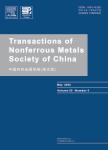版权所有:内蒙古大学图书馆 技术提供:维普资讯• 智图
内蒙古自治区呼和浩特市赛罕区大学西街235号 邮编: 010021

作者机构:北京大学工学院材料科学与工程系高能量密度物理数值模拟教育部重点实验室 应用物理与技术研究中心湍流与复杂系统国家重点实验室北京100871 华北电力大学电站设备状态检测与控制教育部重点实验室北京102206
出 版 物:《Transactions of Nonferrous Metals Society of China》 (中国有色金属学报(英文版))
年 卷 期:2014年第24卷第5期
页 面:1610-1618页
核心收录:
学科分类:080503[工学-材料加工工程] 08[工学] 0805[工学-材料科学与工程(可授工学、理学学位)]
主 题:Hastelloy C22 coating laser cladding acid solution cavitation corrosion electrochemical impedance spectroscopy
摘 要:The Hastelloy C22 coatings on Q235 steel substrate were produced by high power diode laser cladding technique. Their corrosion behaviors in static and cavitation hydrochloric, sulfuric and nitric acid solutions were investigated. The electrochemical results show that corrosion resistance of coatings in static acid solutions is higher than that in cavitation ones. In each case, coating corrosion resistance in descending order is in nitric, sulfuric and hydrochloric acid solutions. Obvious erosion-corrosion morphology and serious intercrystalline corrosion of coating are noticed in cavitation hydrochloric acid solution. This is mainly ascribed to the aggressive ions in hydrochloric acid solution and mechanical effect from cavitation bubbles collapse. While coating after corrosion test in cavitation nitric acid solution shows nearly unchanged surface morphology. The results indicate that the associated action of cavitation and property of acid solution determines the corrosion development of coating. Hastelloy C22 coating exhibits better corrosion resistance in oxidizing acid solution for the stable formation of dense oxide film on the surface.